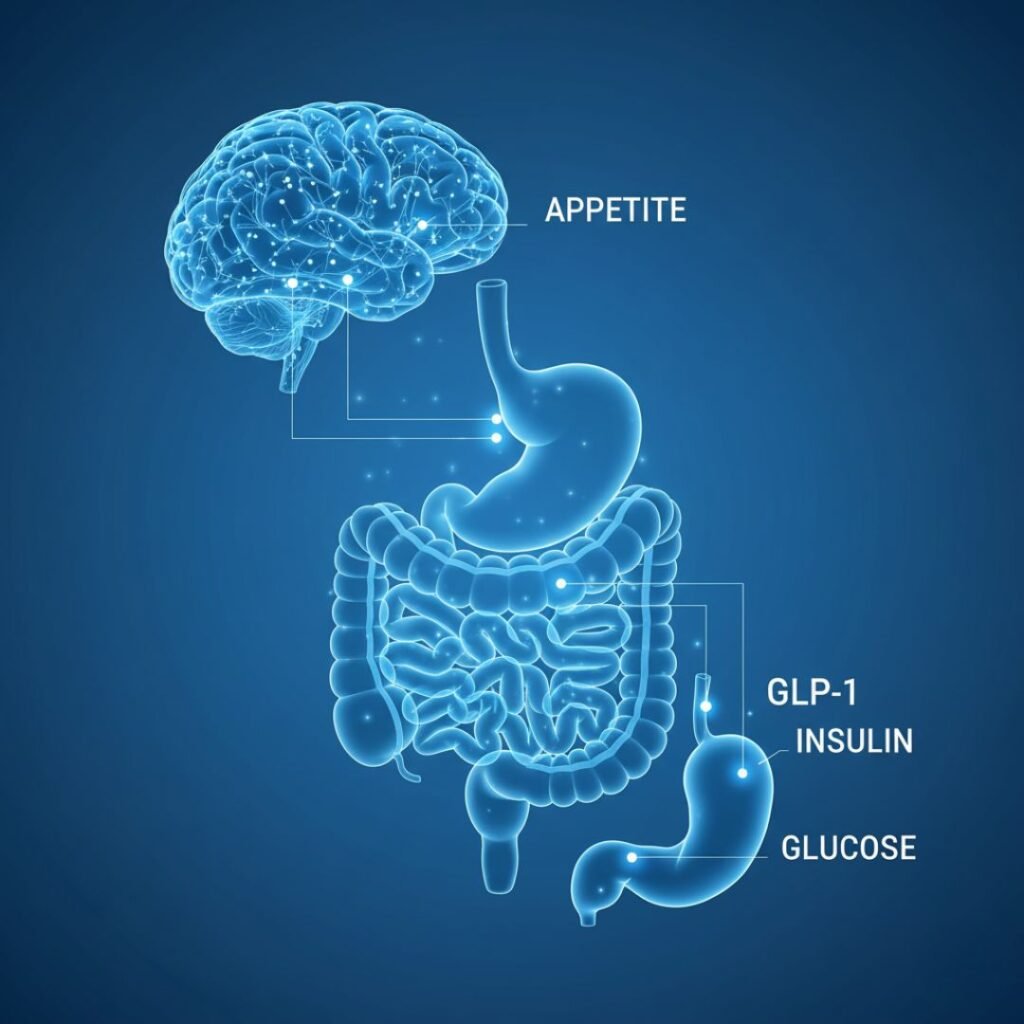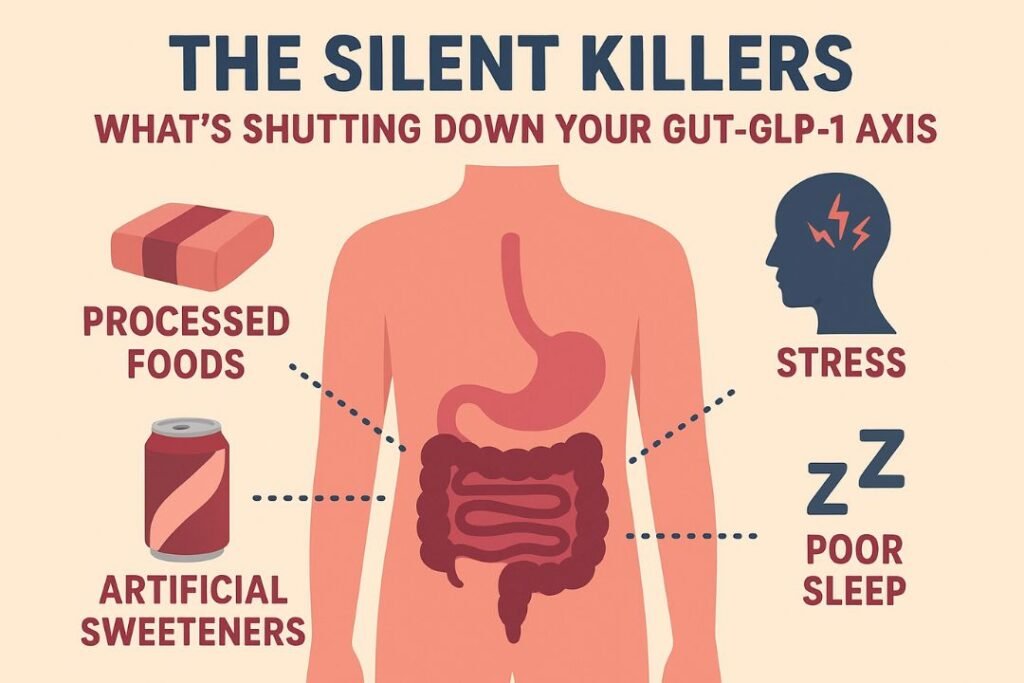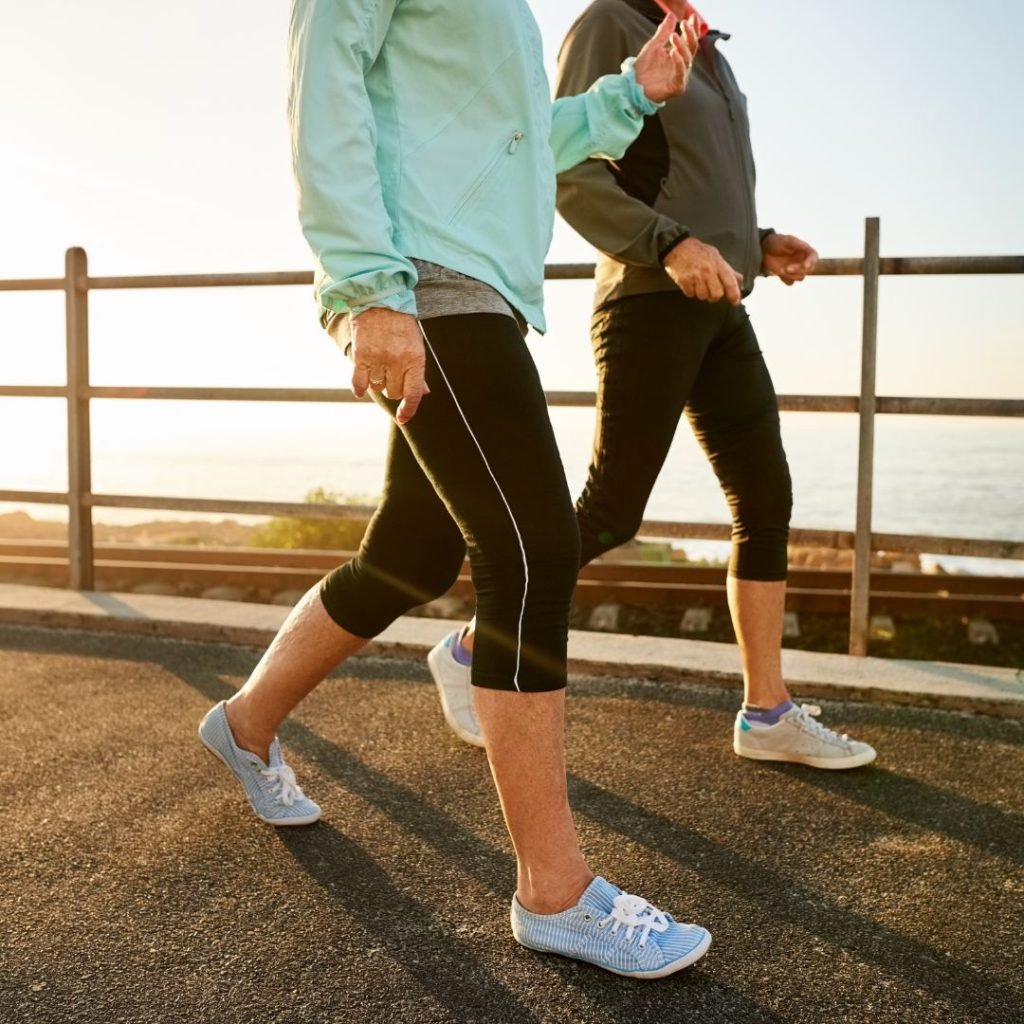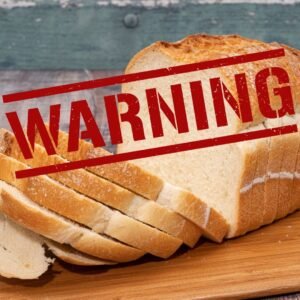Gut Health and GLP-1: The Hidden Link to Weight and Energy
Table of Contents
The Hormone Everyone’s Chasing (But Your Gut Already Makes)
Everyone’s talking about GLP-1.
Doctors are prescribing it. Celebrities are injecting it. Pharmaceutical companies are printing money with it.
But here’s the truth no one seems to mention: your body was designed to make GLP-1 on its own—naturally, powerfully, and safely. You don’t need a needle. You need a healthy gut.
Because right now, millions of people are paying thousands of dollars to artificially activate a system their body already has—the gut-hormone connection that controls hunger, weight, blood sugar, and energy. Yet most people have silently destroyed it with their lifestyle. Their gut is inflamed, sluggish, and underperforming, and so the very hormone they’re trying to mimic with injections has been silenced from the inside out.
This isn’t a conspiracy—it’s a biological fact. And if you’ve been feeling tired, bloated, moody, or stuck in a constant loop of cravings and energy crashes, it’s not because your willpower is weak. It’s because your gut isn’t producing GLP-1 the way it’s supposed to.
Your gut health and your GLP-1 levels are inseparable. One feeds the other. When your gut is balanced, you make more GLP-1 naturally—your body becomes its own appetite suppressant, its own fat burner, its own stabilizer. When it’s off-balance, no amount of diet, caffeine, or “motivation” can save you.
This is the untold story behind the hormone everyone’s chasing.
And by the end of this article, you’ll know exactly how to turn your gut into a GLP-1 powerhouse—without injections, without side effects, and without letting Big Pharma own your metabolism.
TL;DR
GLP-1 is the body’s natural “fullness hormone,” produced in your gut. It helps regulate appetite, blood sugar, and energy levels. Drugs like Ozempic and Wegovy artificially mimic GLP-1, but your gut can make it on its own—if it’s healthy. Certain gut bacteria and fiber-rich foods trigger natural GLP-1 release, while processed foods, stress, poor sleep, and inflammation suppress it. The key to effortless weight control and stable energy isn’t a weekly injection—it’s rebuilding your gut environment so it produces GLP-1 the way it was designed to.
By supporting your gut through clean eating, movement, sleep, and proper elimination (yes, your daily poop matters more than you think), you can reactivate the same pathways billion-dollar drugs are trying to replicate—naturally.
Key Takeaways
Your gut is the factory that makes GLP-1. When it’s balanced, you produce this hormone effortlessly, leading to better blood sugar control, appetite regulation, and energy balance.
Synthetic GLP-1 drugs are just shortcuts with side effects. They work by imitating what your gut already does—but at the cost of nausea, constipation, and dependency.
Certain foods and habits turn on your natural GLP-1 system. Prebiotic fibers, fermented foods, resistant starches, movement, and sleep can all raise GLP-1 levels naturally.
Constipation kills your gut rhythm—and your hormone balance. When waste stays in your system too long, toxins build up, inflammation increases, and GLP-1 production drops.
The PoopSTICK helps your gut do its job. Proper bathroom posture improves colon alignment, supports healthy elimination, and keeps your gut-brain axis functioning at its best.

The Science of GLP-1 — Your Built-In Appetite Regulator
Let’s start with what GLP-1 actually is—without the medical jargon. GLP-1 stands for glucagon-like peptide-1, a hormone made in the L-cells of your small intestine. Think of it as a biological traffic cop for your metabolism. When you eat, your gut releases GLP-1, which signals your brain that you’re full, slows how quickly food leaves your stomach, and helps your pancreas manage blood sugar properly.
In plain English: GLP-1 tells your body to stop eating and start using energy efficiently.
Here’s where the problem starts. When your gut health is compromised—when inflammation, bad bacteria, or poor digestion set in—those L-cells don’t fire properly. The signal gets weak. You stay hungry longer. You crave sugar. Your blood sugar spikes and crashes. You gain weight even when you’re eating “healthy.”
That’s when the pharmaceutical industry steps in with synthetic GLP-1 drugs like Ozempic, Wegovy, and Mounjaro. These injections mimic the natural hormone to trick your body into thinking it’s full. And yes—they work. Temporarily. But they also come with nausea, constipation, muscle loss, and a long list of “we don’t know yet” long-term side effects.
What they don’t tell you is this: the body’s natural GLP-1 system is meant to self-regulate. It knows when to activate and when to calm down. Synthetic versions override that rhythm—like flooring the gas pedal in a car with no brakes.
The good news? Your gut can make GLP-1 on its own again. But you have to rebuild the factory from the ground up.
The Gut — Where GLP-1 Is Born and Broken
If GLP-1 is the hormone, the gut is the factory that makes it.
Inside your intestines live trillions of microorganisms—bacteria, yeasts, and microbes—collectively called your microbiome. Some of these microbes are GLP-1 boosters. Others are GLP-1 blockers. The difference between the two is the difference between effortless energy and stubborn exhaustion.
Certain bacteria, such as Akkermansia muciniphila and Bifidobacterium longum, have been shown in studies to stimulate GLP-1 production naturally. They ferment dietary fiber into short-chain fatty acids like butyrate, which then signal your intestinal L-cells to release more GLP-1.
When you destroy those bacteria—through antibiotics, processed foods, artificial sweeteners, or chronic stress—you effectively shut down the hormone switch. Your gut stops sending the fullness signal to your brain, and your entire metabolic rhythm collapses.
And here’s the kicker: constipation is one of the biggest, most overlooked gut disruptors. When stool builds up in the colon, toxins and inflammatory compounds get reabsorbed into your bloodstream. That inflammation spreads throughout the gut lining, damaging the very cells that produce GLP-1. You can eat all the kale you want—but if your colon isn’t emptying properly, your GLP-1 system is under siege.
This is where gut health and bathroom posture intersect. The position you poop in affects how efficiently your colon empties. When you sit flat-footed on a toilet, your colon is kinked like a garden hose. But when you raise your knees—like with The PoopSTICK—you align the rectum for complete elimination. That means fewer toxins, less inflammation, and better hormonal balance.
You can’t fix your gut hormones if you’re not pooping right.
It’s that simple.
Food — The Natural Trigger for GLP-1 Production
Forget the endless list of banned foods and miracle diets. When it comes to GLP-1, it’s not about eating less—it’s about feeding your gut what it needs to make more of this hormone naturally.
Your body is a chemistry lab, and food is the raw material. When you eat the right stuff, your gut bacteria ferment it into short-chain fatty acids that tell your L-cells to release GLP-1. When you eat the wrong stuff, that process shuts down.
So, what are the right foods?
Start with soluble fiber—the kind found in oats, beans, lentils, and barley. Soluble fiber absorbs water, forming a gel-like substance that feeds your beneficial bacteria. As they digest it, they produce butyrate, propionate, and acetate—metabolites that kickstart GLP-1 release.
Next, add resistant starches, like green bananas, cooked-and-cooled potatoes, and rice. These act as prebiotics—fuel for your gut microbes. They help regulate blood sugar, reduce inflammation, and enhance natural hormone signaling.
Then, include fermented foods—kimchi, kefir, sauerkraut, miso, and yogurt with live cultures. These reintroduce friendly bacteria that directly support GLP-1-producing pathways.
Finally, consume polyphenol-rich foods—berries, green tea, olive oil, and dark chocolate. These compounds nourish beneficial bacteria while suppressing the bad ones.
But here’s what kills the process: processed foods, artificial sweeteners, and stress. These disrupt the microbiome balance, reducing the bacteria that trigger GLP-1 and allowing harmful strains to dominate.
Think of your gut like soil. Feed it junk, and it rots. Feed it fiber, and it blooms.
If you want to feel full faster, balance your blood sugar, and stop living in snack mode, you have to rebuild your gut’s ecosystem meal by meal.

The Silent Killers — What’s Shutting Down Your Gut-GLP-1 Axis
https://thepoopstick.com/the-role-of-sleep-in-gut-health-and-digestion-how-quality-sleep-supports-optimal-gut-function/You can eat clean, pop probiotics, and still struggle with weight and energy if you’re unknowingly sabotaging your gut in other ways.
The modern lifestyle is a GLP-1 killer. Every soda, every late-night stress scroll, every missed hour of sleep chips away at your gut’s ability to produce and regulate hormones.
Processed foods are obvious villains—but it’s not just sugar and carbs. Preservatives, seed oils, and emulsifiers erode your gut lining and feed harmful bacteria that block GLP-1 release.
Artificial sweeteners like sucralose and aspartame are worse. They trick your taste buds without feeding your gut bacteria, leading to dysbiosis—an imbalance where the bad microbes thrive and the good ones die.
Stress is equally destructive. When cortisol spikes, digestion slows, gut permeability increases, and inflammation rises. Chronic stress essentially tells your body, “Survival mode—store fat.”
And then there’s sleep deprivation. Poor sleep disrupts the circadian rhythm of your gut microbiome. Studies show that even one night of bad sleep can alter the bacteria responsible for glucose and hormone balance.
Put simply: your body doesn’t need another diet—it needs an environment where your gut can function the way it was designed to.
That starts with the basics—whole foods, movement, rest, and proper elimination. You can’t detox if you’re not removing waste efficiently. The PoopSTICK’s role here isn’t just mechanical—it’s hormonal. By improving elimination, you’re clearing the path for your gut to reset its balance and start signaling GLP-1 production again.


Rebooting Your Gut’s GLP-1 System — A Step-by-Step Reset
Now that you understand the link, let’s talk about how to bring your gut and GLP-1 levels back online. This isn’t about a cleanse or a supplement stack. It’s about returning your gut to the environment it evolved for.
Step 1: Clean up the input.
Cut out the fake foods—anything ultra-processed, fried, or sugar-loaded. These feed the wrong microbes and inflame your gut lining. Replace them with fiber-rich whole foods that fuel GLP-1 production naturally.
Step 2: Reintroduce life to your gut.
Fermented foods daily. A probiotic supplement if needed. Think of it as reseeding the soil after a drought. The goal is diversity—different bacteria strains, different fibers, different colors of plants.
Step 3: Move after meals.
Even a 10-minute walk post-meal can improve digestion, reduce blood sugar spikes, and stimulate gut motility—all essential for maintaining GLP-1 rhythm.
Step 4: Sleep like it matters.
You can’t out-supplement a broken sleep cycle. Aim for consistency—7–9 hours per night. This is when your gut repairs itself and your hormones recalibrate.
Step 5: Manage stress strategically.
Chronic stress is hormonal poison. Meditation, deep breathing, time in nature, or simple unplugged moments can lower cortisol and restore gut-brain harmony.
Step 6: Poop like you’re designed to.
Yes—your bathroom posture matters. Elevating your feet using The PoopSTICK aligns your colon naturally, allowing smoother, complete elimination. That single change reduces inflammation, supports healthy microbial turnover, and improves the very gut environment where GLP-1 is made.
When you combine these six habits, your gut becomes an active, living GLP-1 factory again. You’ll notice cravings fade, digestion improve, and energy levels stabilize—not because of a pill, but because your body is back in sync.
The New Way Forward — Heal the Gut, Harness the Hormone
Here’s the truth no ad campaign or drug commercial will ever tell you: you don’t need to inject health. You need to restore it.
The multibillion-dollar GLP-1 industry exists because our modern lifestyles have broken the system that nature already perfected. Our guts are inflamed, our diets sterilized, our movements restricted. But the solution isn’t outside us—it’s within.
When you repair your gut, you reactivate your body’s natural intelligence. You give your internal pharmacy permission to do its job again. You stop chasing external fixes and start producing internal balance.
This isn’t a theory—it’s biology. Every person reading this has the capacity to turn their gut into a natural GLP-1 engine. You can wake up with real energy, feel satisfied after meals, and watch your body naturally regulate its hunger, mood, and metabolism.
But you have to start with the fundamentals—and elimination is one of them. The PoopSTICK was designed for that very purpose: to restore the natural, anatomical position your body needs to fully eliminate waste. Because when your gut is clean, your hormones work. When your hormones work, everything else falls in line.
If you want to boost your GLP-1 levels, start by improving your gut health—and if you want to improve your gut health, start with how you poop.
Thousands of years of human biology can’t be wrong. We were made to squat, not strain. The PoopSTICK brings that natural alignment back into your modern bathroom—quietly, discreetly, and effectively.
You don’t need injections. You don’t need extreme diets.
You need a healthy gut—and a clear path for it to function.
Ready to feel the difference?
Visit ThePoopSTICK.com and experience the simplest, most natural way to support your gut health and boost your body’s natural GLP-1 power—every single day.
Because real health doesn’t come in a syringe.
It starts in your gut. And it leaves your body, one healthy poop at a time.
Join our Email List
About the Author

James
Founder of The PoopSTICK | Gut Health Advocate | Healthcare Pro
I’m James, the guy who talks about poop so you don’t have to (but probably should). With over 12 years of experience in the healthcare world—and a family history of colon cancer which made gut health personal—I created The PoopSTICK to give people a better, more natural way to poop.
After trying almost every pooping gadget, toilet stool, and gut health trend under the sun, I realized most products were uncomfortable, overhyped, or just plain awkward. So I built something better—designed for real humans who want real results.
The PoopSTICK isn’t just a product; it’s part of a movement to take gut health seriously (while still laughing a little). Through our blog, I share natural health tips, poop-positive education, and easy ways to take control of your digestion—because better bowel movements should be a normal part of life, not an embarrassing mystery.
If you're someone who cares about health, wants to feel better naturally, or just wants to poop like a champion, you're in the right place.
Let’s talk sh*t—so you can get rid of it better.

James
Founder of The PoopSTICK | Gut Health Advocate | Healthcare Pro
I’m James, healthcare veteran and gut health advocate on a mission to help you poop better—naturally. With over 12 years in the industry and a personal drive to prevent colon cancer, I created The PoopSTICK after being let down by every “solution” out there.
This isn’t just a stick—it’s a movement (literally). I mix humor, health tips, and real talk to make better bowel movements something we can actually talk about.
Let’s ease your poop!
Past Blog Posts

Is Wheat Wrecking Your Gut? What Celiac Disease Reveals
Wheat isn’t the villain—it’s the kind of wheat that’s wrecking your gut. From ancient grains to modern hybrids, discover how today’s wheat triggers inflammation, worsens celiac symptoms, and sabotages digestion—and what smarter, safer alternatives can finally bring your gut back to balance.

Loaded Water: The Hidden Threat to Your Gut Health
Your gut might be under attack every time you take a sip of water. “Loaded water” — filled with hidden chemicals and disruptors — could be wrecking your microbiome without you even knowing it. Here’s what’s really in your glass, how it affects digestion, and what you can do to fight back.

How to Improve Your Pooping and Fix Your Gut for Good
Still straining on the toilet? Your posture—not your diet—might be the real problem. Discover how fixing the way you sit can transform your poop from painful to powerful. This isn’t just a bathroom hack—it’s backed by science, and it works fast. Ready to poop like nature intended? Let’s flush the myths.

